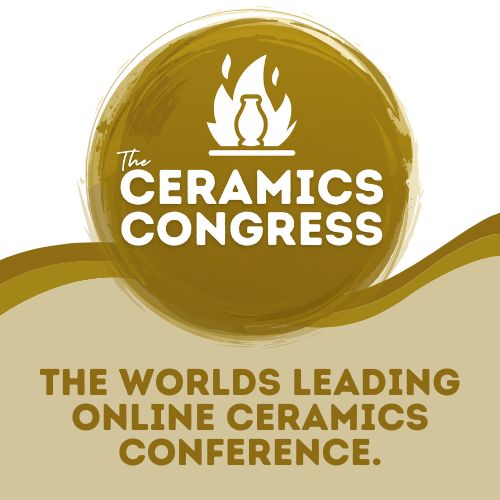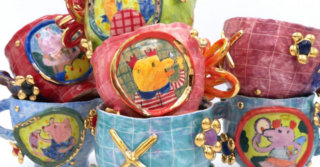If you’ve a clay artist and have come across organizations such as guilds, artist unions, or craft councils, but aren’t really sure what they do or if they’re for you, then today’s article is for you!
While guilds and councils might not have the glitz and glamor of high street galleries, their impact on the creative world is definitely worth understanding. With their distinctive histories and missions, they’ve been nurturing artistic talent, creating essential support systems, and championing the rights of artisans and artists for generations. In this blog, we’ll take a closer look at guilds, craft councils, and artist unions, exploring their origins, and functions, as well as the benefits and drawbacks of joining their ranks.
Whether you’re a seasoned potter, an aspiring sculptor, or simply curious about these organizations, join us as we dive into everything you need to know about them!
What Exactly is a Guild or a Craft Council?

/san-diego-potters-guild-2/
Put simply, a guild or craft council is an organization of artists designed to support the arts within a given geographical region. They exist around the world, and represent artists at municipal, state/provincial, federal, and even international levels. You’ll also come across organizations referring to themselves as Associations, Federations, or Unions, but generally speaking they all serve to promote the arts and advocate for social, financial, and legal support for artists. They also advocate for specific standards within their supported media, encouraging growth and excellence.
One distinction you may come across is the specificity of the art types supported by the respective groups. In general, guilds are the most specific. You’ll see separate guilds for potters, wood turners, textile artists, blacksmiths, etc. Craft councils, on the other hand, represent artists who work in any craft medium or craft tradition. And arts councils, while typically associated with ‘fine art’ processes like painting and sculpting, represent all artists no matter what the medium, including video artists, performance artists, and installation artists. While the debate about the separation between craft and fine art is ongoing, don’t let that put you off from considering joining an arts council; ceramic artists are typically very welcome in fine art circles, particularly today, with clay being used by more and more artists who do not classify themselves as traditional crafts people.
A Brief History
While it is commonly thought that the craft guild emerged in the middle ages of Europe, they actually go back even further. In the ancient Akkadian Empire of Mesopotamia, artisan guilds in various cities adopted a set of standardized measurements and payments1 to bring consistency to their craft. This was in 1750 BCE! Guild-like organizations also existed in ancient Rome. These structured associations of traders, known as collegium, focused on a specific craft, with fully voluntary membership.2
The concept of the guild did take on particular force during the high medieval period of Europe. These organizations formed so that their members could benefit from mutual aid, ensure production standards were maintained and that competition was reduced.3 This was achieved by setting a number of standards in relation to the quality of products, materials used, wages, as well as duration and quality of apprenticeships, restrictions on client poaching, and rights to holidays. Over time, these guilds had immense social and economic influence, strongly contributing to the emergence of the new middle class, and even contributing to the development of modern universities.4 Despite their initial good intentions, these early organizations eventually failed to fairly represent all craftspeople as they became increasingly specialized, exclusive, and political. And, as industrialization increased, these guilds began to see a decline.
Today’s guilds are probably most strongly influenced by those of the late 1800s, which came about with the Arts & Crafts Movement in Britain. While rooted in the same ideas of support and labor protections of earlier models, guilds of this period were more focused on creating artistic communities where artists and craftsmen lived and worked together, forging links with local industries, training local artisans, supporting the development of education in art and craft for the widest possible audiences, and creating commercial ventures to help sell arts and crafts products.5 There was less emphasis on specialization, and more interest in reestablishing the importance of all craft and applied arts in society at large, at a time when craft was seen as a low art, or even passé.
Guilds and Councils Today
Today’s guilds, councils, and artists unions offer many benefits, as well as coming with some stipulations and potential drawbacks. We’ll give you a thorough overview below, but keep in mind that each organization has its own mandate, which may not include all of the features we cover here.

-potters-guild-show-sale/
Benefits
Advocacy: One of the strengths of these organizations is that they advocate for the rights and visibility of artists in their area. Fair pay is often a struggle for artists (with a recent survey in the UK finding the average artist there is paid just £2.60/hour!), and often one of the mandates of councils is to pay artists fairly for exhibitions, workshops, and talks, and to encourage other businesses to do the same.
Build Connections with Local Businesses: Guilds and councils also promote the value of handmade and locally made products to businesses in the area, which means your work gets seen by more people. Sometimes this takes the form of them hosting wholesale shows for potential clients to discover your work, or doing direct outreach to businesses.
Sales Opportunities: Frequently, guilds and craft councils will have a shop, either at their headquarters, or in a commercial area. Selling your work here will usually require you to pass a standards approval process (more on this to come!), along with accepting either consignment or wholesale rates. What’s great about these shops is that they’re usually well regarded for the quality of work presented and therefore draw a desirable audience, and the salespeople are well versed in the value of craft. In some cases, the guild may require you to work in the shop a set number of hours a week, though this is less common.
In cases where the guild doesn’t have a brick and mortar shop, they will often offer annual or biannual member sales events at local venues.
Exhibition Opportunities: Guilds will also frequently have gallery spaces, overing you opportunities to present your work. This can take the form of group shows, annual members’ exhibits, and solo shows. Unlike many commercial gallery opportunities, you are usually paid for your effort, on top of any sales you may make.
Funding: This is another big benefit of joining a guild or craft council. While this can vary greatly from guild to guild, many have grants available. This can include small scholarships for education and workshops, startup grants for setting up your studio, or project grants to support your latest production project. Many will have year-end achievement awards as well to celebrate the successes of their members, and some have emergency funds in case you’re faced with significant challenges such as illness, or unexpected damage to your studio.
Affiliate Deals: Many craft councils have secured discounts for members with relevant organizations. This can include pottery suppliers and museums, as well as liability, medical, or employment insurance providers.
Education Opportunities: Guilds frequently offer workshops throughout the year, both as multi-week sessions and one-off weekend workshops with visiting or local artists. Teaching opportunities are often available to members, so you can share your knowledge too. Artist talks and exhibition tours are also common, and some will even host annual or biannual symposiums to bring in inspiring artists.
Community: One of the biggest benefits of joining an arts organization is the opportunity to build community and meet like-minded, clay-obsessed people like yourself! Through classes and special events, they’ll get you out of your solitary studio and mingling with other makers. And as most councils are member-run, you can choose to participate on the board and give back to the community that supports you.
Considerations

Membership Fees: Joining a guild or craft council is sadly not free. You’ll be expected to pay an annual membership fee, which can vary widely from organization to organization. This can be as little as $50 a year, or as much as $400. Luckily, most guilds have membership tiers. Usually there are reduced rates for students, and if you want to sell in the shop or exhibit, you can expect to pay more.
Standards Process: Like the original guilds of the Middle Ages, most of today’s organizations have a written code of standards with the aim of promoting excellence in craft. While this can be motivating for many, it can exclude others whose backgrounds, traditions, or physical abilities lead them towards a non-standard approach or aesthetic. Beauty is, of course, in the eye of the beholder, so sometimes the standards set can be biased or outdated. Broadly speaking though, the aim is to ensure that the work promoted by the guild is safe, fit for use, and well constructed.
Generally, the standards process consists of submitting work in person for peer review, where it’s then judged against the list of standards set by the organization. Not all councils require you to go through this process for all membership tiers, but some do. If you are unsure if your work is ready for this you can often arrange a consultation with a member, and if you disagree with the decision made by the guild’s jury, there is usually an appeal process available.
Time Commitment: Guilds and councils are member-run, so you can expect to commit some time each year to help keep things running smoothly. Usually this means attending annual members’ meetings and voting in board elections. While not a strict requirement, it’s well worth your time participating in these events so that the people making decisions best represent your needs. If you choose, you can commit more time and energy by joining a committee or becoming a board member yourself, it’s really up to you.
Accessibility: While arts organizations are widely available, they aren’t everywhere, especially in smaller communities. In cases where only a state/provincial option is available, their headquarters, events, and shops may be many kilometers away from you, making it difficult or expensive for you to participate. Since the pandemic, many more are offering online options for workshops and meetings, which make it easier. Distance will not prohibit you from accessing their funding however, provided you fall within their jurisdiction.
In many instances, you will have access to multiple organizations. You could join your city’s pottery guild, your region’s arts council, or your state’s craft federation. While you are certainly not restricted from joining all of them, for many of us this can get a bit pricey, especially with the current economic challenges. So before you sign up and send off that membership fee, have a close look at their mandates, funding opportunities, workshop offerings, and other benefits, so that you choose the group that will best support you and your practice. If possible, consider attending an event to see what the community is like too.
From their historical origins to their modern-day roles, these organizations have demonstrated an enduring role in nurturing artistic talent, safeguarding artisan rights, and shaping the vibrant art and craftsmanship landscape. While they are not without imperfection, guilds, craft councils, and artist unions remain champions of the creative process and its importance in society. We hope you’ve gained a deeper understanding of the value these institutions may offer you.
If you are already a member of a guild or council in your area and would like to help others find them, be sure to tell your board members to sign up for The Ceramics Directory. We’re on a mission to share and promote ceramics organizations, artists, and studios from around the world, and we’d love to add them!
And if you don’t have any access to arts organizations where you are, don’t fret! The Ceramic School is the community for you. You can receive the same educational and social benefits that you would with a guild, with a truly global approach that you can access right from your home!






Responses